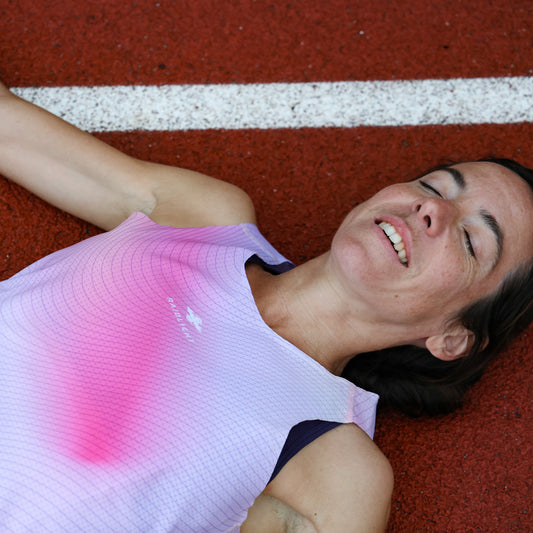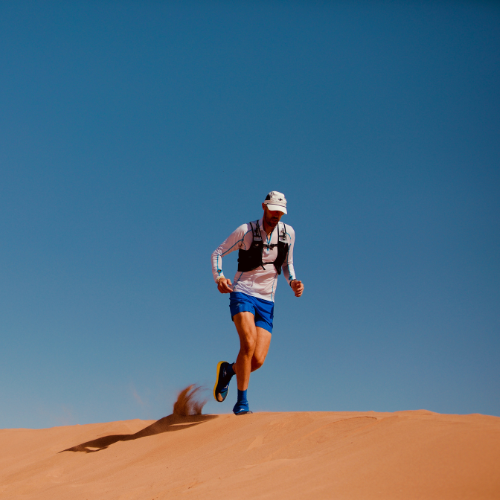Nutrition is essential for runners, as it influences not only performance on the trails, but also recovery and general well-being. Adopting a balanced and appropriate diet helps to sustain the intensity of training while promoting good health. In this article, Marie shares her essential tips for optimal daily nutrition for trail runners. You'll discover practical tips for preparing meals tailored to the energy requirements of this activity. Whether you're a novice or an experienced trail runner, these recommendations will help you fuel your passion while maintaining a healthy lifestyle on a daily basis.
Marie is a Raidlight ambassador and passionate about sports nutrition, a field in which she has a degree. She works as an advisor in the Raidlight boutique, where she enthusiastically shares her expertise in equipment for outdoor activities. A trail runner and road racer, Marie finds her balance by enjoying outdoor activities while aiming for performance..

General advice on basic sports nutrition to be applied throughout the year :
Disclaimer: The basic advice on a balanced diet applies to everyone, whether you're a sedentary person, an occasional sportsperson, a competitive amateur or a top-level sportsperson. The difference lies in the rigour with which you apply them.
The idea here is not to set up a strict diet, but rather to be aware of these intakes and be able to manage and adjust them throughout the year according to training periods and objectives, while adapting to everyday life!
Base your diet on unprocessed products:
The most important advice is to limit ultra-processed foods. As well as often lacking essential micronutrients (vitamins, minerals, trace elements) and being unbalanced in terms of macronutrients (too fatty, too sweet, insufficiently rich in protein), they are also full of additives that weaken the intestinal wall and encourage inflammatory reactions. Although it is now difficult to avoid these foods altogether, it is advisable to eat them only on special occasions.
To manage your sports diet effectively throughout the year, the best thing to do is to draw up a basic plan that you can adapt to your needs on a daily basis.
The body needs regularity, and meals taken at set times every day optimise the digestibility of food. There are several possible eating patterns, depending on your schedule and habits.
3-course meal plan :
Breakfast: 1 portion of starchy foods + 1 protein + 1 fat (+ fruit) and 1 sufficient water.
Lunch: (divide the plate into 4 portions) 2 portions of vegetables (raw and/or cooked) + 1 portion of starchy foods + 1 portion of protein + 1 portion of fat (in the form of raw oils, +/- 1 tablespoon) + 1 dessert (fruit + dairy products or equivalent).
Dinner ( same recommendations as for lunch).
4-course meal plan :
Breakfast: 1 portion of starch + 1 protein + 1 fat (+ fruit) and sufficient water.
Lunch: (divide the plate into 4 portions) 2 portions of vegetables (raw and/or cooked) + 1 portion of starchy foods or pulses + 1 portion of protein + a fat contribution (in the form of raw oils, +/- 1 tablespoon).
Snack: 1 to 2 portions of fruit + one portion of protein and one portion of fat (for example: 150g of red fruit + 60g of Bündnerfleisch + about ten almonds).
Dinner: (same recommendations as for lunch).
5-course meal plan:
Breakfast: 1 portion of starchy foods + 1 protein intake + 1 fat intake (+ fruit) and a sufficient water intake.
Snack: 1 portion of fruit + about ten almonds/nuts, etc., and a drink.
Lunch: (divide the plate into 4 portions) 2 portions of vegetables (raw and/or cooked) + 1 portion of starchy foods and/or pulses + 1 portion of protein + a fat intake (in the form of raw oils, +/- 1 tablespoon).
Snack: 1 portion of fruit + one protein and one fat (for example: 150 g of red fruit + 60 g of Grisons meat + about ten almonds).
Dinner: (same recommendations as for lunch).
It's perfectly possible to add an evening snack during periods of intense training. For example, a bowl of fromage frais with a little sweetener (honey, jam, compote) or a hot chocolate with a dozen almonds or walnuts.
The official recommendations for hydration are 35 ml of water per kilo of body weight. For someone weighing 70 kilos, that's at least 2.45 litres of water a day. It is also advisable to drink between 500 ml and 1 L of extra water per hour of physical activity, or more in hot weather. These recommendations apply to everyone, whether or not you experience digestive problems during exercise or on a daily basis. If you have a particular sensitivity or a weakened intestinal microbiota, taking probiotics can be very beneficial in strengthening the intestinal wall, improving the assimilation of nutrients and preventing intestinal infections.
Finally, there's no need to be excessively strict: if you don't have a weight problem, the aim is simply to maintain a regular, balanced diet to keep you in good general physical condition, promote recovery and preserve digestive health.

Managing pre-race feed :
Now that the basics are in place and your daily diet is optimised, you can concentrate on preparing for your race!
About a week before the race, avoid alcohol. As well as disturbing the intestinal microbiota, it requires a considerable effort from the body to eliminate it. Its diuretic and dehydrating effects also reduce the body's ability to use its glycogen reserves efficiently.
Four or five days before the race, it is recommended to increase carbohydrate intake to boost glycogen reserves. However, it is common for athletes to adopt the ‘large portions of pasta and maltodextrin drinks’ diet, which risks exhausting the digestive system due to carbohydrate overload. Maltodextrin should be used either for a carbohydrate rebound after a dissociated diet, or to avoid increasing carbohydrates in meals. In other words, choose between maltodextrin or increased carbohydrate intake, but not both!
In practice, if you want to consume maltodextrin, you need 0.5 to 1g per kg of body weight diluted in water, to be taken throughout the day 3 days before exercise.
For sensitive people, it is advisable to reduce or even eliminate gluten and dairy products in the week before exercise. Gradually reducing fibre intake can also be beneficial. The aim is to focus on the essentials: an optimum intake of proteins, carbohydrates and fats, with foods that are easy to digest and increasingly simple meals.
Example of a meal the day before the race, without maltodextrin (if you use maltodextrin, eat only one portion of starch):
Add 1 to 2 tablespoons of raw oil and season with salt. Avoid strong spices, but you can use turmeric, cumin or fennel, which are known for their digestive properties.
Find out more about Marie's advice in a forthcoming article dedicated to nutrition on race day. She'll also be sharing her tips for avoiding digestive problems and optimising your performance.











1 comment
Bonjour, j’ai toujours une fringale quand j’arrive vers le 30e K. Que faire? Cordialement.
Frédéric